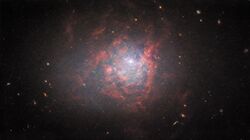Astronomy:NGC 1705
| NGC 1705 | |
|---|---|
 NGC 1705. Credit: NASA. | |
| Observation data (J2000 epoch) | |
| Constellation | Pictor |
| Right ascension | 04h 54m 13.500s[1] |
| Declination | −53° 21′ 39.82″[1] |
| Redshift | 633 ± 6 km/s[2] |
| Distance | 16.6 ± 2.0 Mly (5.1 ± 0.6 Mpc)[3] |
| Group or cluster | Dorado Group |
| Apparent magnitude (V) | 12.56±0.03[4] |
| Characteristics | |
| Type | SA0− pec[2] or BCD[3] |
| Apparent size (V) | 1′.86 × 1′.45[5] |
| Other designations | |
| PGC 16282[2] | |
NGC 1705 is a peculiar lenticular galaxy and a blue compact dwarf galaxy (BCD)[3] in the southern constellation of Pictor, positioned less than a degree to the east of Iota Pictoris,[6] and is undergoing a starburst.[7] With an apparent visual magnitude of 12.6[4] it requires a telescope to observe. It is estimated to be approximately 17 million light-years from the Earth,[8] and is a member of the Dorado Group.[9]
This is a relatively isolated galaxy, with its nearest neighbors being more than 500 kpc distant. However, its neutral hydrogen disk shows a significant amount of warp, suggesting that the outer gas is still settling into place.[3] The mass models of the galaxy suggest the dominant source of mass is a dark matter halo.[10] It has a super star cluster located near the galactic center,[10] and shows strong galactic winds.[3] Designated NGC1750–1, this cluster has a maximum radius of 2.85±0.50 pc and is 12±6 Myr old.[11]
The major starburst activity is happening at the core of the galaxy, within the central ~150 pc, and this is providing the main ionizing source out to distance of ~1 kpc or more.[7] Over the last 10 million years it has added 5.7×105 M☉ worth of stars.[3] The younger stars in the galaxy with an age below a billion years have an estimated 6×107 M☉ and are mainly concentrated near the center, while the older star populations have 2.2×108 M☉ and form a more extended distribution. The total mass of neutral hydrogen in the galaxy is estimated at (2.2±0.2)×108 M☉.[10]
References
- ↑ 1.0 1.1 Skrutskie, Michael F.; Cutri, Roc M.; Stiening, Rae; Weinberg, Martin D.; Schneider, Stephen E.; Carpenter, John M.; Beichman, Charles A.; Capps, Richard W. et al. (1 February 2006). "The Two Micron All Sky Survey (2MASS)". The Astronomical Journal 131 (2): 1163–1183. doi:10.1086/498708. ISSN 0004-6256. Bibcode: 2006AJ....131.1163S.
- ↑ 2.0 2.1 2.2 "NASA/IPAC Extragalactic Database". Results for NGC 1705. http://nedwww.ipac.caltech.edu/.
- ↑ 3.0 3.1 3.2 3.3 3.4 3.5 Cignoni, M. et al. (March 2018). "Star Formation Histories of the LEGUS Dwarf Galaxies. I. Recent History of NGC 1705, NGC 4449, and Holmberg II". The Astrophysical Journal 856 (1): 17. doi:10.3847/1538-4357/aab041. 62. Bibcode: 2018ApJ...856...62C.
- ↑ 4.0 4.1 Cook, David O. et al. (2014). "Spitzer Local Volume Legacy (LVL) SEDs and physical properties". Monthly Notices of the Royal Astronomical Society 445 (1): 899–912. doi:10.1093/mnras/stu1787. Bibcode: 2014MNRAS.445..899C.
- ↑ Paturel, G. et al. (December 2003). "HYPERLEDA. I. Identification and designation of galaxies". Astronomy and Astrophysics 412: 45–55. doi:10.1051/0004-6361:20031411. Bibcode: 2003A&A...412...45P.
- ↑ Sinnott, Roger W.; Perryman, Michael A. C. (1997). Millennium Star Atlas. 1. Sky Publishing Corporation and the European Space Agency. p. 458. ISBN 0-933346-84-0.
- ↑ 7.0 7.1 Annibali, F. et al. (November 2015). "Chemical Abundances and Properties of the Ionized Gas in NGC 1705". The Astronomical Journal 150 (5): 23. doi:10.1088/0004-6256/150/5/143. 143. Bibcode: 2015AJ....150..143A.
- ↑ Nemiroff, R.; Bonnell, J., eds (April 23, 2003). "The Stars of NGC 1705". Astronomy Picture of the Day. NASA. https://apod.nasa.gov/apod/ap030423.html.
- ↑ Huchra, J. P.; Geller, M. J. (June 15, 1982). "Groups of galaxies. I - Nearby groups". Astrophysical Journal 257 (Part 1): 423–437. doi:10.1086/160000. Bibcode: 1982ApJ...257..423H.
- ↑ 10.0 10.1 10.2 Elson, E. C. et al. (March 2013). "H I synthesis observations of the blue compact dwarf NGC 1705". Monthly Notices of the Royal Astronomical Society 429 (3): 2550–2561. doi:10.1093/mnras/sts526. Bibcode: 2013MNRAS.429.2550E.
- ↑ Martins, F. et al. (November 2012). "Near-infrared spectroscopy of the super star cluster in NGC 1705". Astronomy & Astrophysics 547: 4. doi:10.1051/0004-6361/201220144. A17. Bibcode: 2012A&A...547A..17M.
External links
- NGC 1705 at ESA/Hubble
- NGC 1705 on WikiSky: DSS2, SDSS, GALEX, IRAS, Hydrogen α, X-Ray, Astrophoto, Sky Map, Articles and images
Coordinates: ![]() 04h 54m 13.5s, −53° 21′ 40″
04h 54m 13.5s, −53° 21′ 40″
 |

